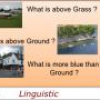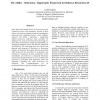611 search results - page 9 / 123 » Using GP to Model Contextual Human Behavior |
CVPR
2010
IEEE
14 years 4 months ago
2010
IEEE
We present an active learning framework to simultaneously learn appearance and contextual models for scene understanding tasks (multi-class classification). Existing multi-class a...
IPPS
1998
IEEE
14 years 4 days ago
1998
IEEE
Predicting the running time of a parallel program is useful for determining the optimal values for the parameters of the implementation and the optimal mapping of data on processo...
IBPRIA
2007
Springer
13 years 9 months ago
2007
Springer
This work describes an approach for the interpretation and explanation of human behavior in image sequences, within the context of a Cognitive Vision System. The information source...
HICSS
2007
IEEE
14 years 2 months ago
2007
IEEE
Some theoretical models used in IS research may lack explanatory power and consistency because of their failure to provide an adequate means of accounting for contextual and situa...
CONTEXT
2007
Springer
14 years 2 months ago
2007
Springer
Abstract. This paper presents a statistical framework based on Principal Component Analysis (PCA) for discovering the contextual factors which most strongly influence user behavio...


